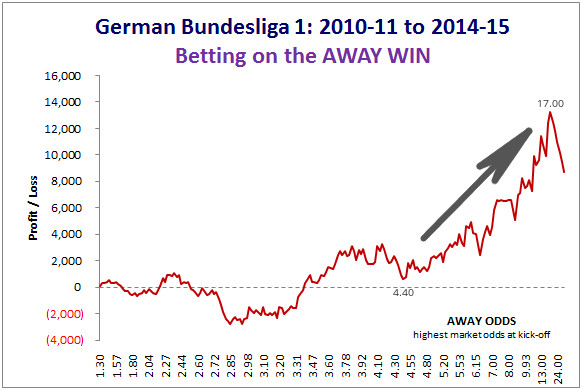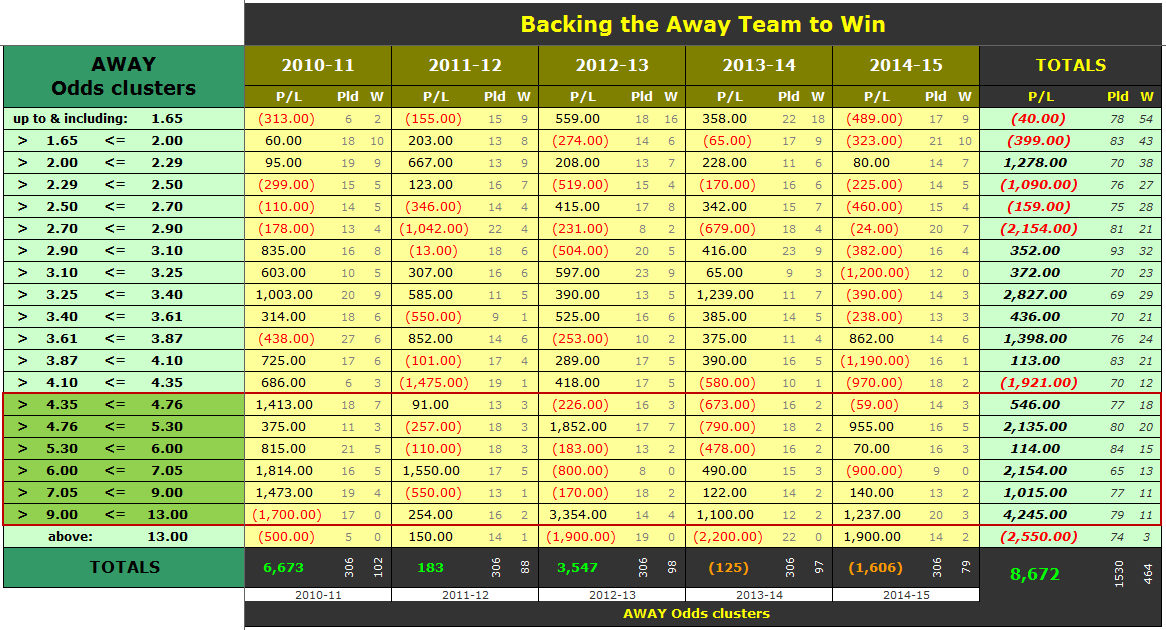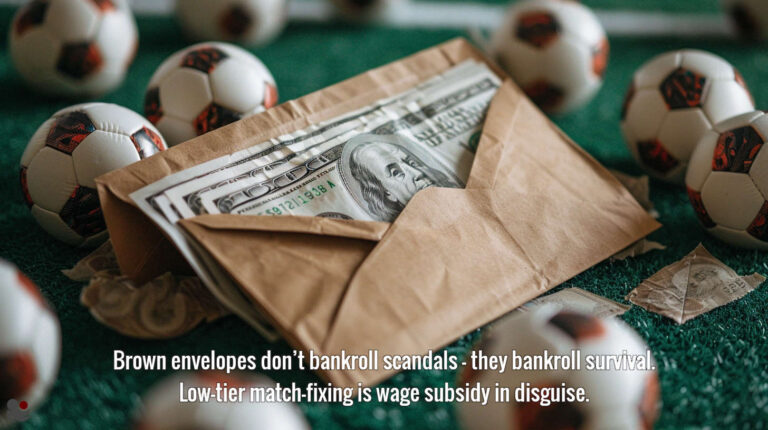
Every year we publish HDAFU simulation tables (Home, Draw, Away, Favourites, Underdogs), which model profit & losses for five seasons in each featured league for developing profitable betting systems.
Today’s article discusses the question what would have happened when backing the underdog playing away from home in the German Bundesliga?
Such a match was played in this league on 23/05/2015 between Moenchengladbach and Augsburg. The best bookmaker odds for the full-time 1×2 market at kick-off were: 1.57 Home; 5.00 Draw; 7.30 Away.
Moenchengladbach were the clear favourites at 1.57; Augsburg the rank outsiders. However, the men of Augsburg won the game, 1-3, defying their long odds.
How regular do such things occur? Is it profitable to bet on outsiders?
Here’s a screenshot from the ‘Backing by Odds’ tab in the simulation table for this league:
In the table above you can see that from a total of 306 matches during 2014-15, the away team won 79 times. (Click on the table to enlarge it in a new browser tab).
79 of 306 is 25.8%, and this percentage shows that the away team won, on average, slightly better than once every four matches.
Profit and Loss Sectors when Betting on the Away Team
Looking at the profit/loss (P/L) summaries in the ‘Totals’ column, adding together the first six rows of odds clusters produces a loss of -2,564 units, based on a flat stake of 100 units per bet.
Essentially this means if the away team was priced as a clear favourite or close to the home team’s prices, they won less frequently than the probabilities indicated by their odds. The last of these first six cluster groups closes at away odds of 2.90.
Look at the second row of the table. The odds cluster between 1.66 (implied probability 60.2%) and 2.00 (implied probability 50%) contains 83 matches and, if the odds had been ‘fair’, 55.1% (60.2% + 50% / 2) of the away teams priced in this group should have won.
As you can see, this was not the case! Of 83 games in five seasons only 43 were away wins (51.8%).
Therefore, punters who regularly backed away favourites in the Bundesliga during 2010-15 surrendered ‘value’ in their bets to the bookmakers. When this happens, only one side of the deal wins in the long-run; invariably it isn’t the bettors!
Okay, let’s take a look at the away underdogs…
 German Bundesliga – ‘Inflection Points’ tab – Five Seasons 2010-15
German Bundesliga – ‘Inflection Points’ tab – Five Seasons 2010-15This screenshot shows a steep rising curve starting at odds of 4.40 and continuing until odds of 17.0.
Over five seasons, 462 matches fell into this group (Moenchengladbach vs. Augsburg being one of them). The away underdog won 88 times = 19% hit rate!
In these odds clusters the away team won, on average, once in every five matches. The average betting odds were 6.40, representing a probability of 15.6%.
The curve shows, as well as the calculations (19%/15.6% = 121.7%), that the mathematical advantage was on the side of the gambler!
The P/L curve registered 653 units profit at the start of our selected segment and finished at 13,727 units. This is a difference of 13,074 units of profit located solely within the away odds cluster group from 4.40 to 17.0.
Why does this advantage exist? How does it happen?
Backing Low Odds Favourites – Downfall of any Betting System
Most bettors prefer betting on the more popular and ‘emotionally safer’ shorter-priced favourites, but please ask yourself the following two questions:
- How does a profit-oriented company (i.e. bookmaker) set its prices?
- Should the prices (odds) for favourites rise or drop?
Both common sense and business acumen prevail in this situation:
The market dynamics are the following: The more bets expected to be placed on a particular outcome, the more bookmakers reduce their odds. Reducing odds mean that the bettor must risk more money (stake more) to achieve the same financial outcome. The punter therefore pays a ‘higher price’ (gets lower odds) for the same product:
Odds 2.0 → stake 50 = win 50
Odds 1.5 → stake 100 = win 50
Odds 1.25 → stake 200 = win 50
Falling odds means:
⇒ Rising stakes
⇒ Potential to lose more money
⇒ Lower percentage returns should the bet win!
Although this relationship may seem paradoxical, falling odds means rising prices!
Bookies adjust Favourite & Underdog Odds to Public Expectations
To reiterate: Falling odds for an outcome is a clear indicator that this is a favourite. Warning! Dropping odds do not indicate that the statistical probability for the favourite winning the game is improving; purely the fact that the outcome is becoming more and more favoured by bettors. This is a betting fundamental, which many gamblers are totally unaware of.
Falling odds mean bookmakers are effectively raising the price for the product! The product itself does not change in the slightest (i.e. betting on the favourite), but it becomes more expensive to buy. The bettor has to risk more money in order to win the same amount. In this case, you do not get ‘more for your money’, but considerably less!
Let’s use a different example. A confectionery company launches a new chocolate bar, which becomes an instant success. Demand increases; the company naturally takes advantage of the situation by raising the price. You can certainly make the statement that if the price of the chocolate increases it is a ‘favourite’, but the product itself never changes – it’s still a 100g chocolate bar!
The last word here is that since the books have to be ‘balanced’ (i.e. the payout of all three 1×2 bets combined needs to add up to around 100%), whilst the ‘prices’ for favourites are lowered to take advantage of the demand, on the opposite side, the odds for the underdogs rise.









Hi,
Thanks for the answer.
I read in one of your articles the it’s possilbe to manually download/export data from Oddsportal.
Well I copyed all the data for a league and inserted it in Excel, but I can’t subscribe the score cell.
For ex: in B1 is the score 1:1, but without suscribing it, you can’t know who was the winner for that match.
Do you know how is it possible to subscribe numbers in one cell?
There is no help in the search engine.
Thanks
Hi Sarkec,
You will have to tweak a little bit.
First, run a “replace” in the column with the scores to put a ‘ before each score. This converts the string into a text string.
Then use the Excel formulas =LEFT() and RIGHT() in two helper columns. This will return you the scores in different columns which you can then use to run an IF function to determine if it was a H-D-A.
Alternatively, just do it manually. It really depends how big your data set is and if fiddling around with Excel and trying to find a formula saves you time or if you are actually faster if you do it manually.
Good luck! 🙂
Hi Soccerwidow!
I have discovered some nice strategys for the summer leagues, but there are a lot and I don’t know what to choose from them to bet in the next season.
I have strategys where have been just <100 bets in 5 seasons and returned a nice profit, strategys that had more than 150 bets in 5 seasons and returned some nice profit and strategys where in 2013 or 2014 where breakeven, or even with minus, but the rest of the seasons it produced nice profits.
What should I choose from them?
Another question: I am using odds from Football-data site, and I don't know if thoose odds were at KO Time, or thoose are opening odds?
What odds should we use when we are betting with a system?
I would like to use the odds days before KO Time, bcs freetime in weekend the most important for me and I don't want to sit in the front of the computer to wait for every match to begin and make my bets..
Thank you!
Hi Sarkec, the odds you find on the Football-data site are from Friday evening for weekend games and Monday evening for week games. I personally prefer to carry out calculations using these odds as it frees weekend time and does not require to sit on the computer the whole weekend.
Unfortunately, the data from Football-data is slightly incorrect as they collect the odds automatically without manual corrections. That means that if a bookmaker had a special marketing activity the ‘highest’ odds may not reflect the true picture.
It therefore makes sense that after you identified a strategy that you make a simulation with Football-data odds and then pick randomly 10 matches from your selected data and check them manually. If they are all ok, then you can safely assume that your strategy will probably also work in practise. If you find only one error in the data, then check another 10 matches. If it stays with only this one error, then it’s fine and nothing to worry, otherwise I would drop the strategy as it’s probably based on wrong data and hence, on wrong assumptions.
but in value calculator page u say it need to use 6h2h for correction factor.
Hi zinphyo, this article about ‘Staking the Underdog’ has nothing to do with the Value Calculator. This article introduces the idea of systematic betting on 1×2 results using the HDAFU tables. The tables are simulations to recognise sweet spots (betting odds clusters) where bookmakers regularly overprice or underprice.
yes. i understand. but i mean in this example gladbach vs augburg when i look up their h2h before this match started u only use 4 h2h matches.
value calculator can use only for 6 h2h matches over 10 years. in this example u use only 4 h2h. is there will be missed calculation in the long run or can i use only 4 h2h ? thank.
6 H2H matches are already a very small number, 4 is insignificant. The H2H calculations are used as a correction factor. What this all means, mathematically, is explained in great length in the Fundamentals of Sports Betting course.
Hey, before the game starts, i see that the odds are changing a lot. What are the different reasons ? And how can you benefit from this mechanism? Thank you very much
Hi Franky,
The odds change all the time in response to customer supply and demand – click on this link to find our other articles How Do Bookmakers Tick? and How Bookmakers’ Odds Match Public Opinion. These will give you some idea why the odds move in the ways they do.
How to take advantage of these movements? Well, we’d be seriously rich if we had a crystal ball and could tell in advance which way the odds were going to move. It is definitely possible to scalp the prices before kick off in an arbitrage fashion, but the profit margins are always going to be small and you need a big bank to begin with to show any worthwhile results – it’s very work intensive, believe me, and one un-covered bet can destroy the accumulated profits earned from dozens of previously successful ones! Try this on paper first until you are 100% confident that you know what you’re doing.
Hello again… So far I’ve made the decision to bet only on the 1X2 market. Over and Under are very unstable for me, and the yields are much much lower than what you can find in Draws or Away patterns.
The larger the cluster, more meaningful the result, although a simple statisticual rule, its not always true. I have used clusters from 2012-2013 2013-2014 that amount to 200 games per season (Spanish La Liga) to see it dip in the 2014-2015, even though their p-values were 1 in 10 000. Of course, it helps a lot to have a larger cluster, but in the end, if you take the time to analyse it you will see that within the cluster there is a pattern that brings solid results.
My suggestion is to watch out for the odds movement (Opening odds VS Closing odds), I’ve discovered that some clusters worked wonders everytime the betting public went for the favorite. Its like magic, there is an obvious relationship in some points, like a NO ODDS MOVEMENT, or PUBLIC BETTING LIKE YOU.
I also think that if you have a system that works in all five seasons and it can be somehow explained by logic (why the underdogs at 4.40 work and not on 3.40 for example) helps to gain confidence.
Since everyone can access this information, its only a matter of time before someone gets to it. Some clusters are statistical anomalies, some are real. This is why I rate teams and combine it with this technique, it helps to get to strategies most wont see thanks to my rating.
I have not tested this yet (I will in a few days), but I think that if we combine your Value Betting technique and see the inflection points it produces with Value propositions, we could get something more effective.
I made an excel file to test 4 banking methods and worst losing streaks, nothing fancy, but I think if you could develop similar but better product would be great.
Thanks again… Im looking forward to that course… And you are right Falconer, the French have a very stable Draw pattern, I have two angles that amount to 179 games combined, producing 87 units on 1 unit per game using closing odds at an average bookmaker.
Hello!
Nice and useful article again, thanks for that!
But unfortunately – as you wrote – this is not that simple!
There are many many profitable clusters in every betting category in every league from the 5 seasons’ set of data, but it’s not mean that these patterns will be profitable in the next season. Unfortunately not at all!
Some will be profitable, some won’t.
Just two example from the Bundesliga (from 2009/10-2013/14 results and highest odds set of data):
Backing draws where the draw odds between 3.55-3.68. These bets brought 10.7% yield. (of course single bets with flat stake). Apply that cluster to the 2014/2015 season: the result was a fantastic 46.3% yield.
Backing away underdog where the away odds between 6-12. These bets brought 31.9% yield, but in the 2014/15 season the cluster brought losses with -13.7 yield.
I studied the efficiency of the 5 seasons’ clusters in every betting category in the new (6.) season in some leagues, but the result was not univoque.
In the Bundesliga 2014/15 the all 9 category profitable pattern following was just 25%.
In some leagues it was 75-80%. BUT there are many 100% in one category and especially in one odds segment (H-D-A).
So according to my observations the solution is that we have to specialise in every leagues’ most profitable betting category, and find the principally typify clusters.
For example the French 2 leaguae with the draws, which is a very-very stable since many years.
Maybe there will be useful to write an article about the clusters lifetime, or practicing.
Regards,
Falconer
Thanks for your comment!
There will be (at some time in the far future) a whole course addressing HDA betting, actually, it will be two courses – one for odds calculation like the Over/Under course, and another one for systematic betting.
Keep making suggestions as it helps planning the course(s).
Loved the article… this is precisely the way I bet. Every year I refine the process with the basic premise of clustering and systematic betting.
I have been willing to ask you, in this example we have 462 games in 5 seasons. What do you think about smaller samples?
For example, if I have a cluster of 50 games, about 10 matches per season on average, but manages to make a profit in all seasons, finishing in 20 units for the whole 5 seasons betting 1 unit (1.4yield) on DRAWS, do you think this is meaningful?
By the way, in previous years HDAFU table I did not see any Inflection Points graph, what about this season file?
Thanks for the article, just in time.
Hi Rod, generally speaking – the larger a cluster the more meaningful. Simple statistical rule.
The inflection point graphs are a new addition to the HDA tables this season. There are 5 of them in the FT tables:
(1) by home odds
(2) by draw odds
(3) by away odds
(4) by favourite odds (home/away)
(5) by underdog odds (home/away)
The HT table contains a 6th inflection point graph for 0:0 HT Correct Score.
I’m working today on putting together a proper product description, and hopefully tomorrow it will be finished and ready for publishing.